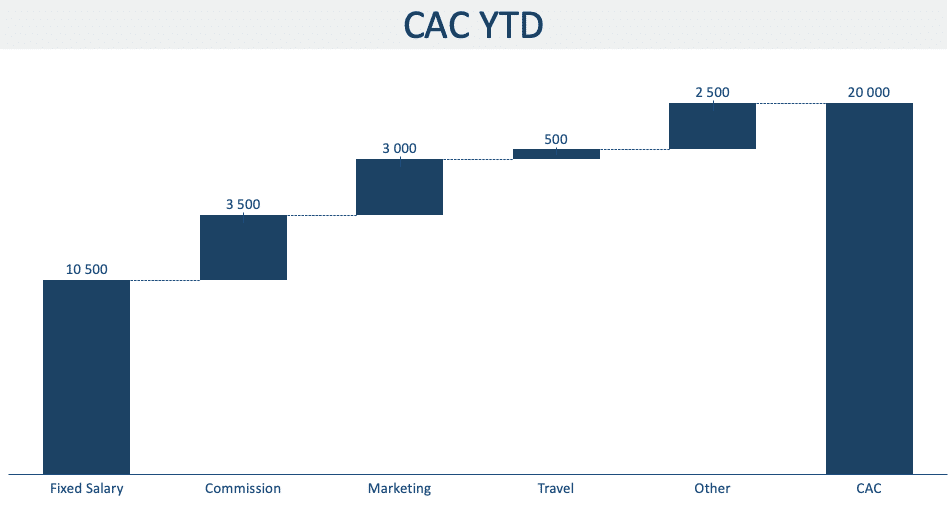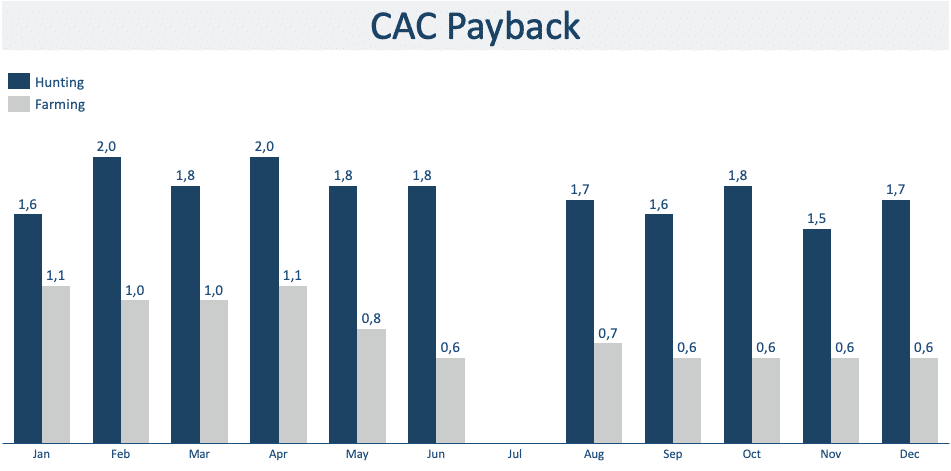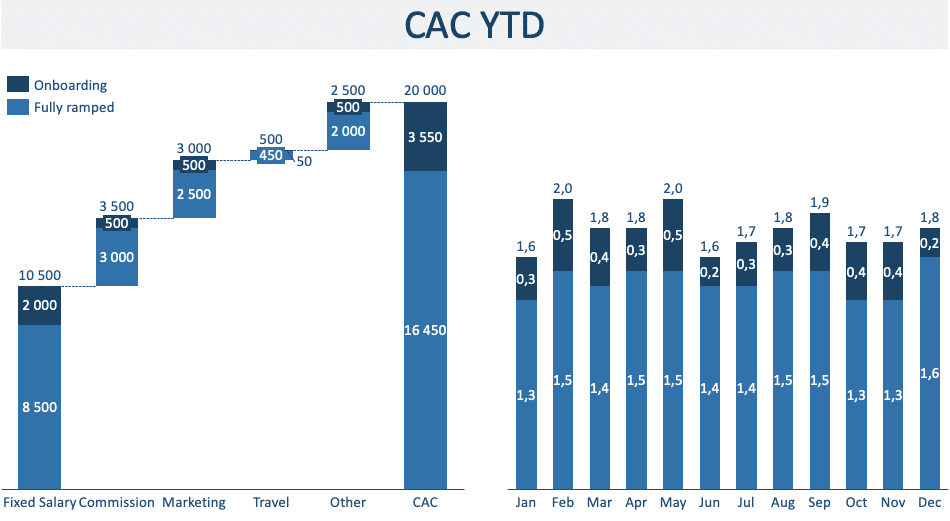How to measure sales efficiency in your software company

Sales efficiency is all about driving the most sales possible from your available resources. To improve your sales effort, you must be able to measure it, and the way to calculate it is easier than you might think. Below, we will outline how to build a scalable sales model, measure sales efficiency, and use the metrics to make smarter decisions on where to prioritize your efforts.
Building a scalable sales model
In our view, building a scalable sales model from lead generation to renewal is all about specialization. It is tough to find people who are experts on everything. Thus, recruiting people for more specialized roles can help you find the right person for the job to succeed at different stages through a sales process.
We typically divide the sales process into lead generation, new sales, and customer success. Within the sales model, each department plays a pivotal role. Lead generation focuses on identifying and nurturing potential clients creating a pipeline of opportunities. The leads can come from both outbound and inbound activities. The new sales team converts these leads into paying customers by showcasing the value of your product or service. Meanwhile, customer success ensures ongoing satisfaction and support, fostering long-term relationships and encouraging upsells and renewals.

By allocating specialized roles for each stage, you optimize the chances of achieving consistent, scalable growth.
How do you calculate sales efficiency?
Calculating sales efficiency could be done by dividing your new annual recurring revenue (ARR) by your total cost of making the sale. The cost of doing a deal includes any direct or indirect expenses occurring in a sales process. These costs could include fixed salary, commissions, sales software, travel, and marketing.

To know where to hire your resources for the highest return, we suggest splitting the costs for new sales (hunting) and upsells (farmers) into separate categories—and, when relevant, by industry or geography.
What is a good sales efficiency ratio?
The metrics we use for sales efficiency are customer acquisition costs (CAC) and CAC Payback. CAC is simply the cost of generating one new customer. You calculate CAC by dividing all your sales & marketing cost by the number of new customers in the period. CAC payback is calculated by dividing CAC by the average ARR per new customer and multiply it by 12. E.g., if you have calculated that your CAC is 10 000 EUR and the average ARR for a new customer is 5 000 EUR, the CAC payback would be (10 000/5 000) x 12 = 24 months. These metrics refer to the cost of acquiring a new customer and the time it takes to recover the acquisition costs. If you have a CAC payback ratio of less than 12 months, you are essentially self-funded.
On average, the CAC payback period for our software companies is 17-18 months for new sales. It is worth noting that the payback time can differ depending on the type of sale (new sales or upsell) and market you are evaluating. The following section will show how to use the metrics to make more informed decision-making.
Make well-informed decisions to improve sales efficiency
Let’s take an example of a company operating in the Nordics. They segment their sales into ‘Hunter’ categories for Norway, Sweden, and Denmark. For each market, they individually assess the CAC payback and the new Annual Recurring Revenue (ARR). They also conduct this evaluation for their hunter team on a consolidated basis and for their customer success team.
As illustrated in the subsequent figure, the detailed reporting offers a comprehensive performance overview across various sales and customer success teams. By comparing CAC payback across different countries and between hunting and farming strategies, you can allocate resources to maximize returns. In this scenario, investing in Customer Success would be most reasonable, which delivers an impressive CAC payback of 0.6.

Onboarding vs. fully ramped: Optimizing Sales Team Performance
When getting new personnel on board, it’s crucial to distinguish between those in the onboarding phase and those who are fully ramped up. It’s essential to assess both new hires and seasoned team members separately. Failing to do so might allow some sellers to camouflage their individual performance within the collective figures. It usually takes 6-12 months for a new employee to become fully ramped.

Identifying your top sellers
Recognizing and tracking your top sellers is essential in minimizing the risks within your sales team. You need a broad base of effective salespeople for your product to scale. If only one or two sellers account for over half of your Annual Recurring Revenue (ARR), you become vulnerable to setbacks should they choose to leave. Thus, monitoring and increasing the number of top-performing sellers within your ranks is crucial.
Conclusion
Sales efficiency is crucial for the success of your software company. You can optimize your resources and maximize your returns by understanding how to build a scalable sales model, from lead generation to customer retention. It’s not just about having a team of sellers but about having the right team with precise specializations while continuously monitoring their performances. You can make informed decisions that drive scalability and sustainability through metrics such as CAC and CAC Payback. It is all about having the right people in the right roles, using precise metrics to guide your journey, and refining your approach proactively.
More tips on Sales Efficiency
Discover insights on improving sales efficiency in our upcoming article on the topic. In today’s competitive market, boosting sales efficiency is key to sustainable growth and success. This comprehensive guide explores essential questions and offers actionable steps to maximize your software company’s sales efficiency. Don’t miss out on this valuable resource for SaaS leaders. Stay ahead and sign up for our newsletter today.